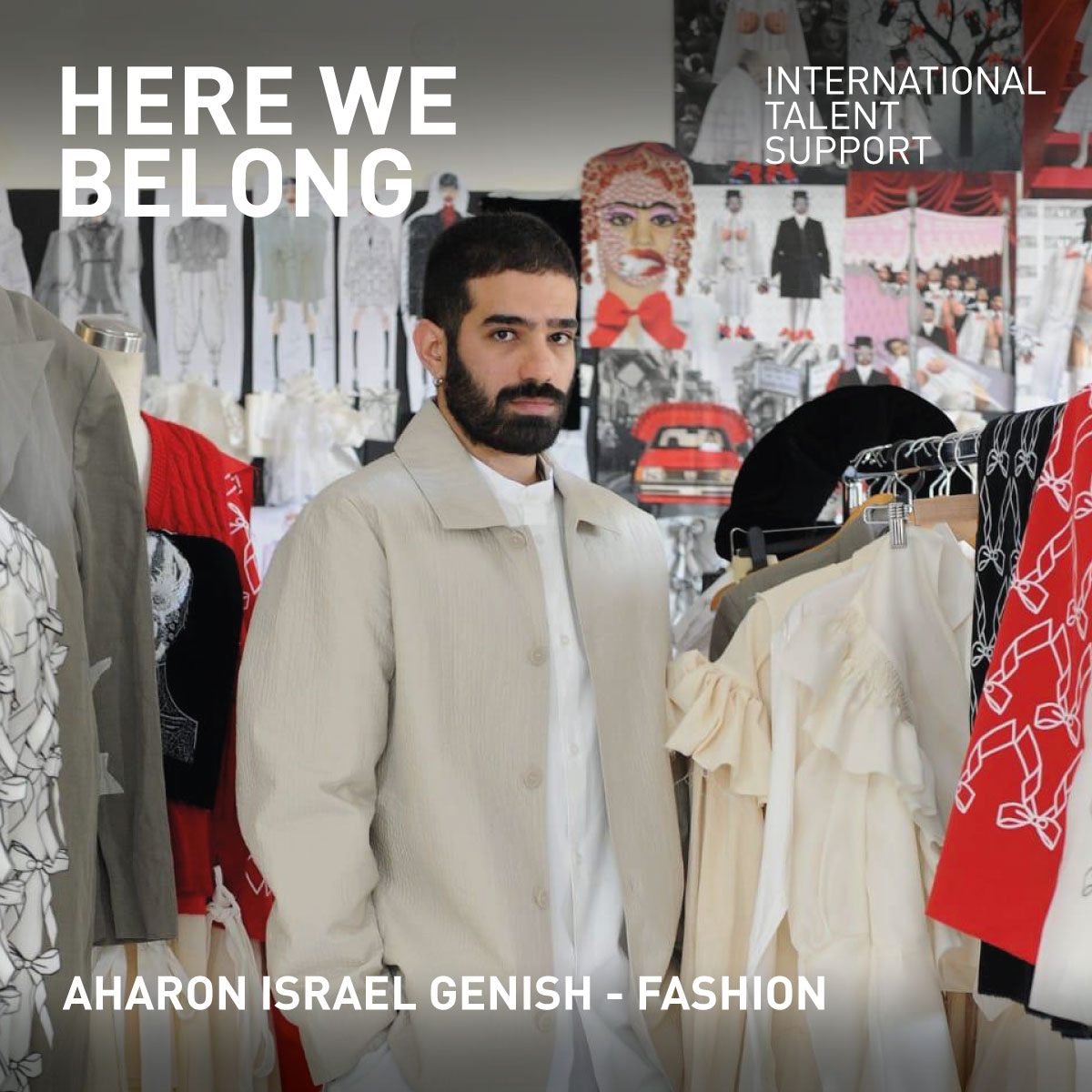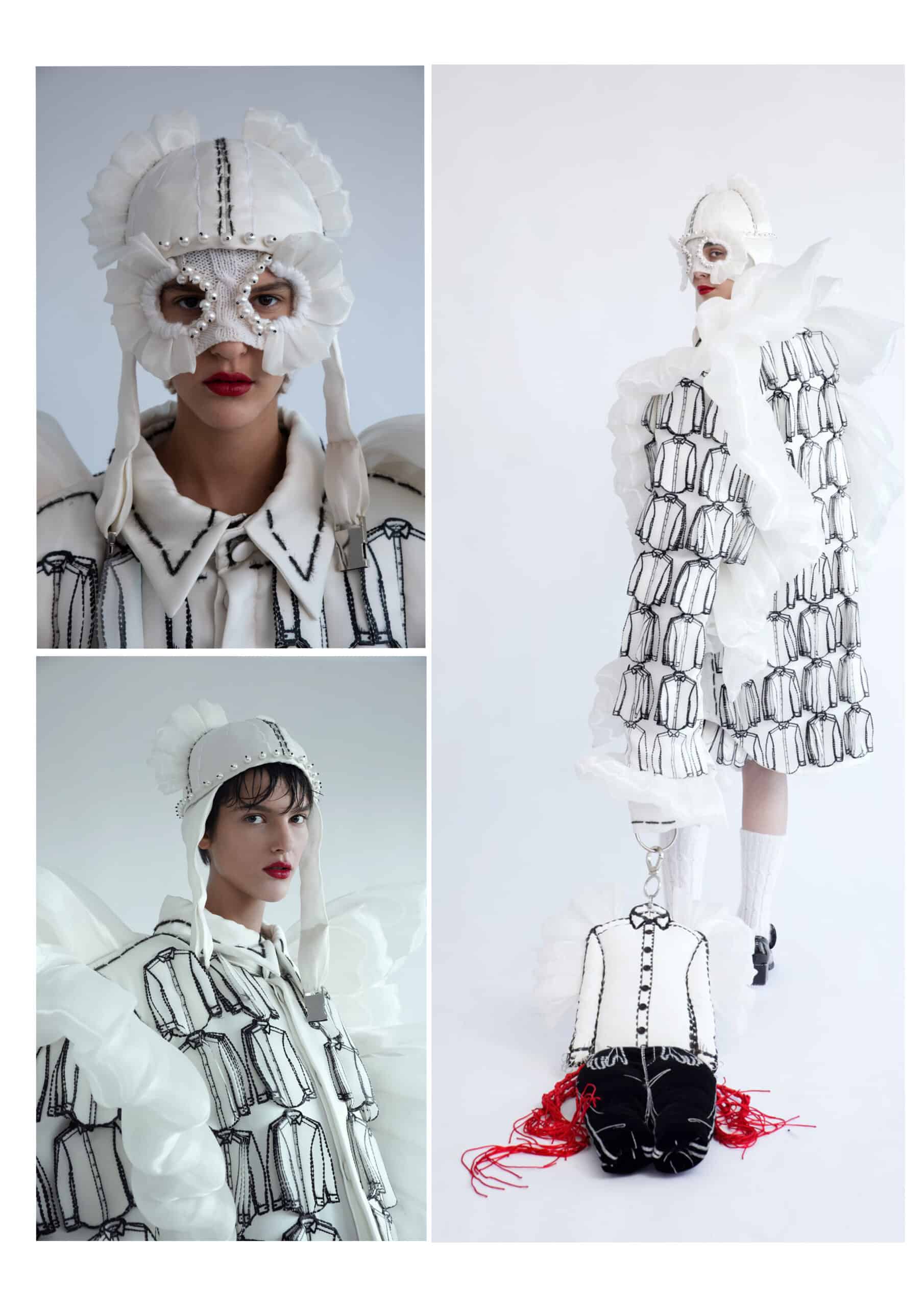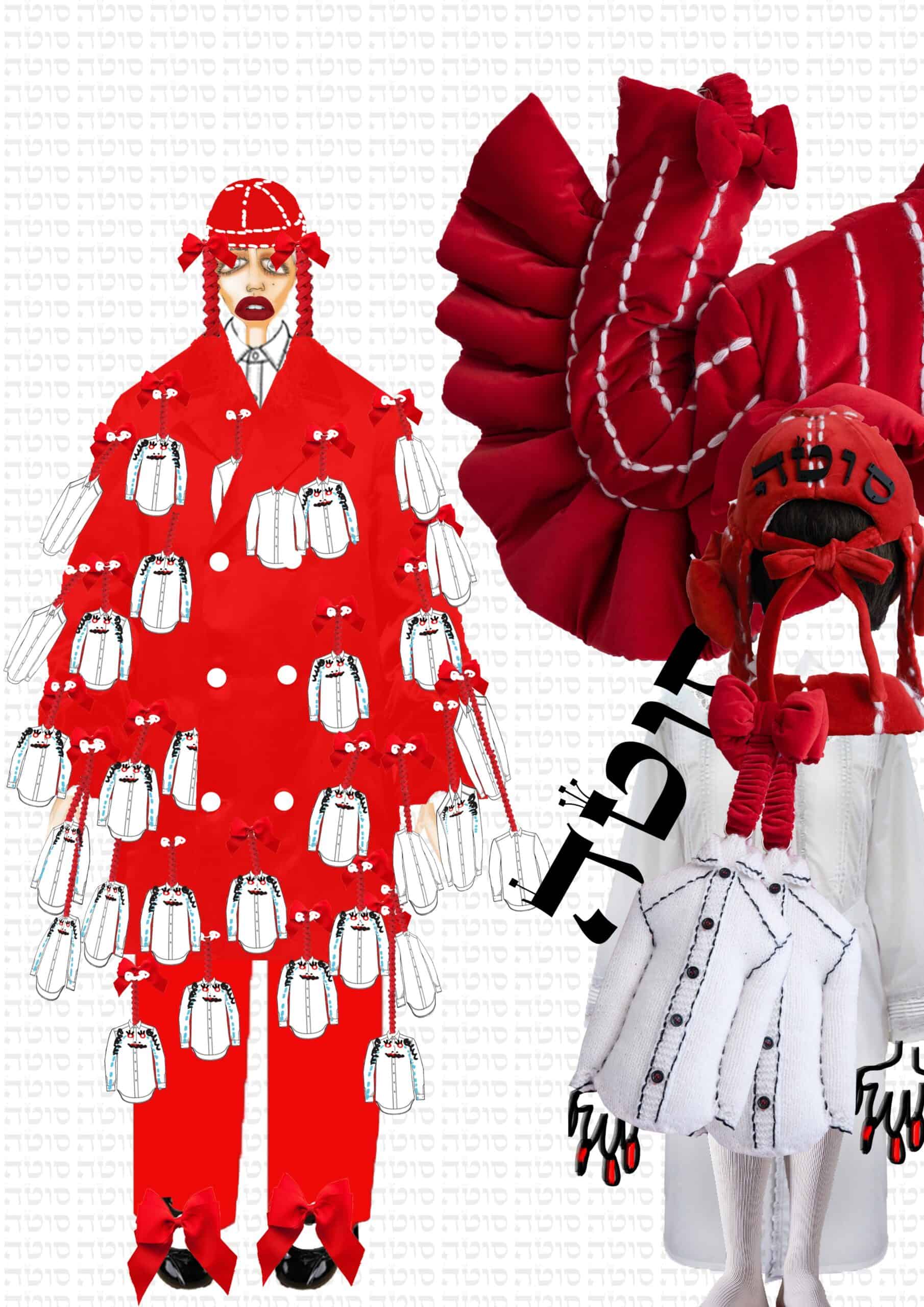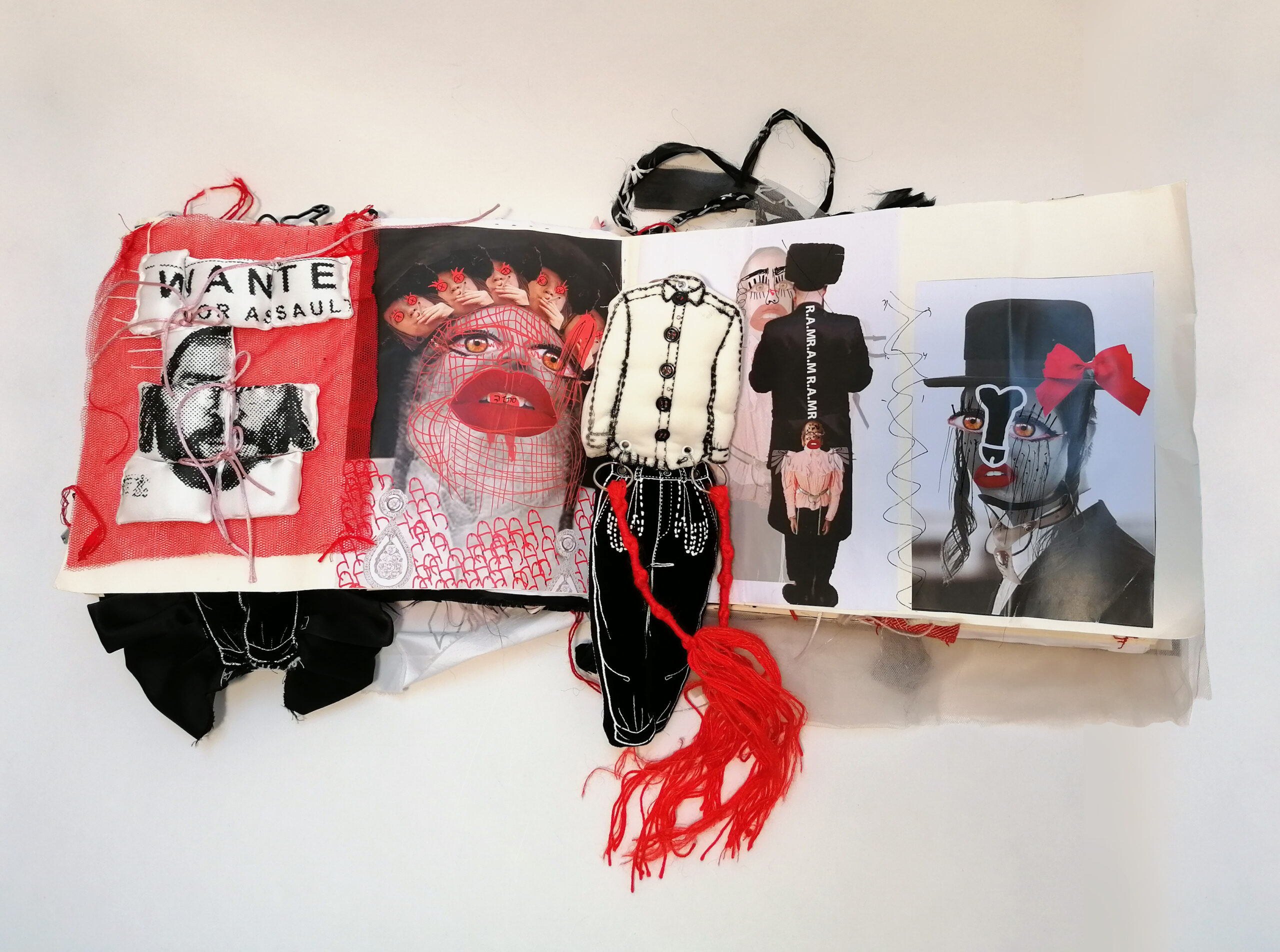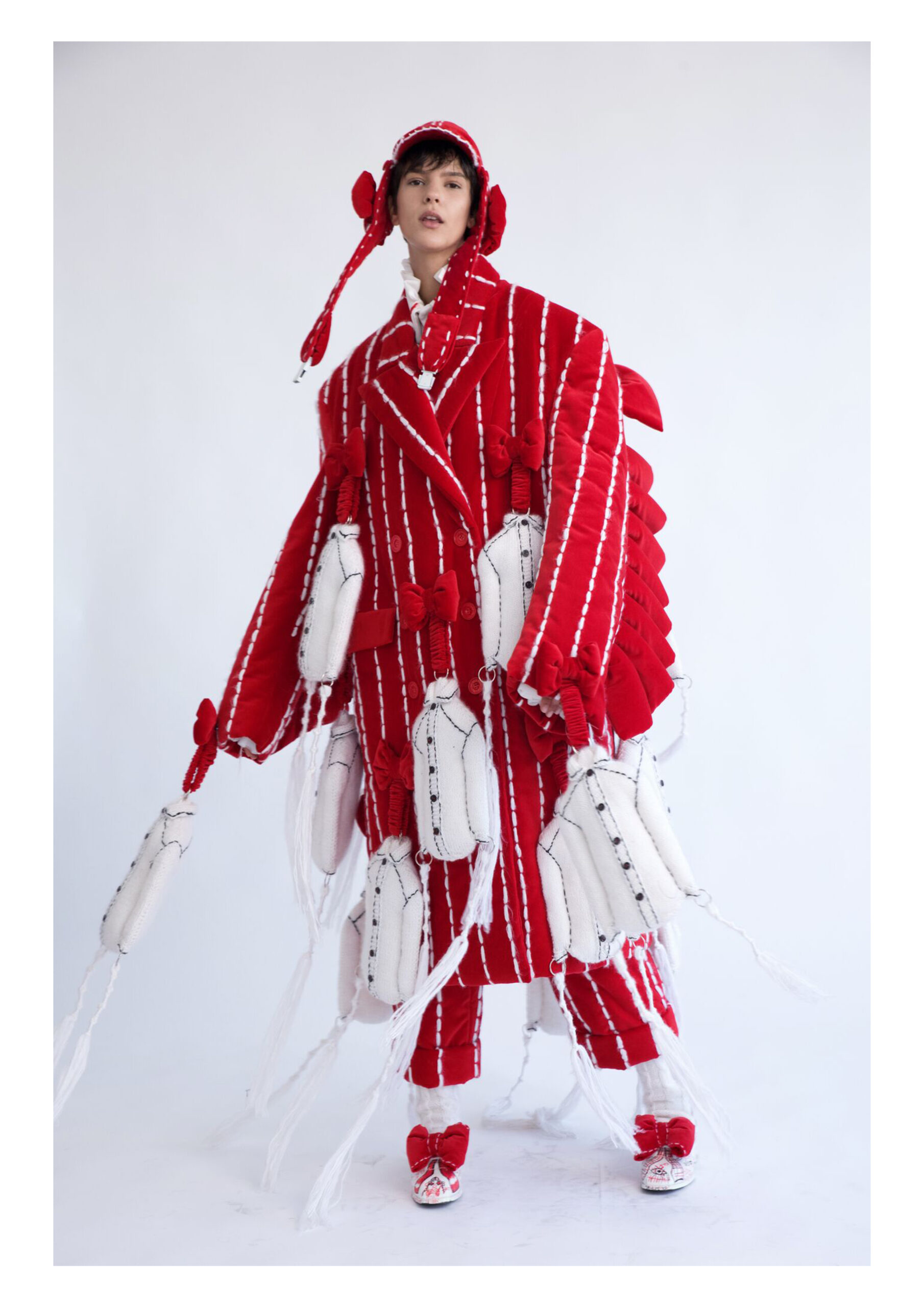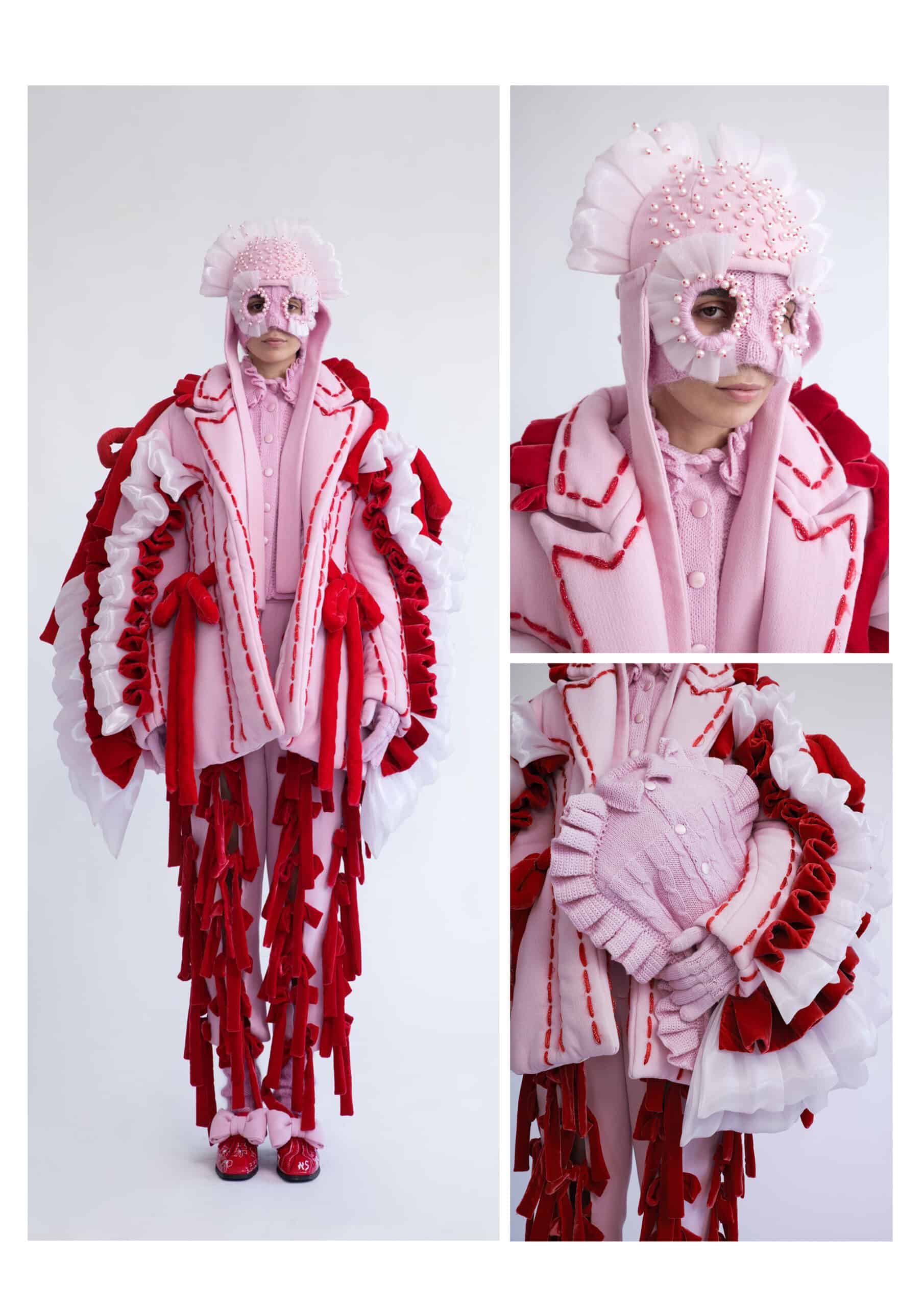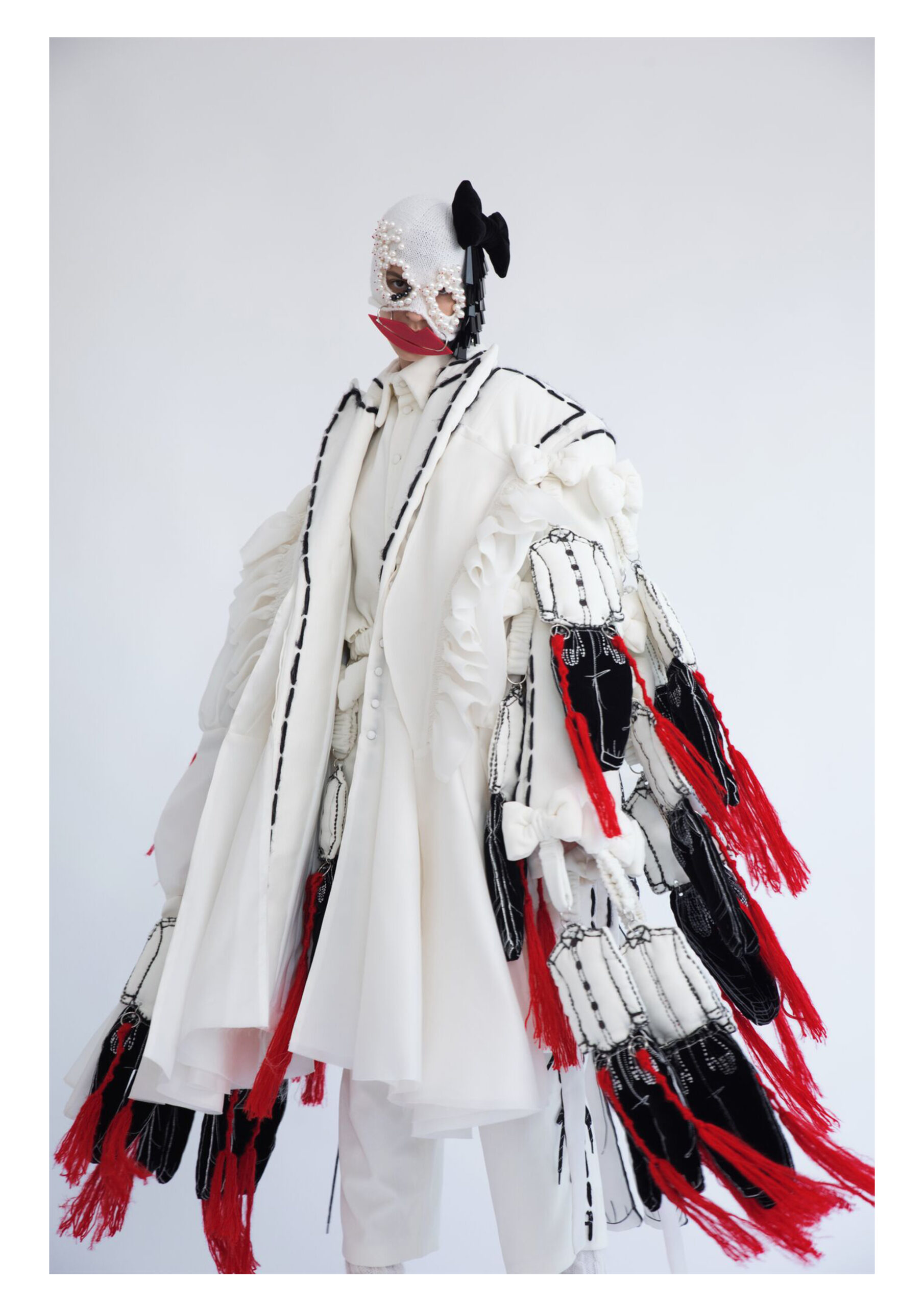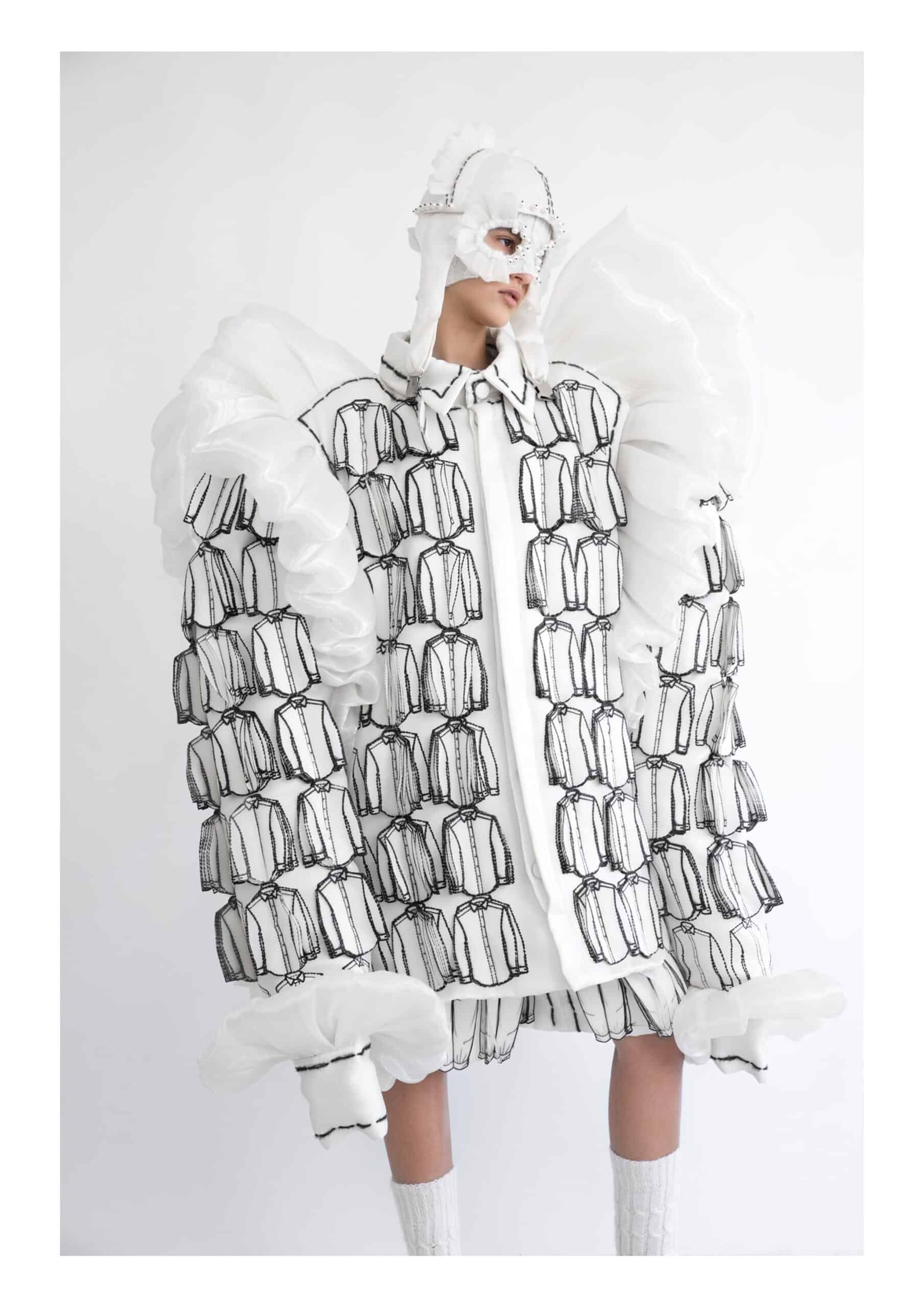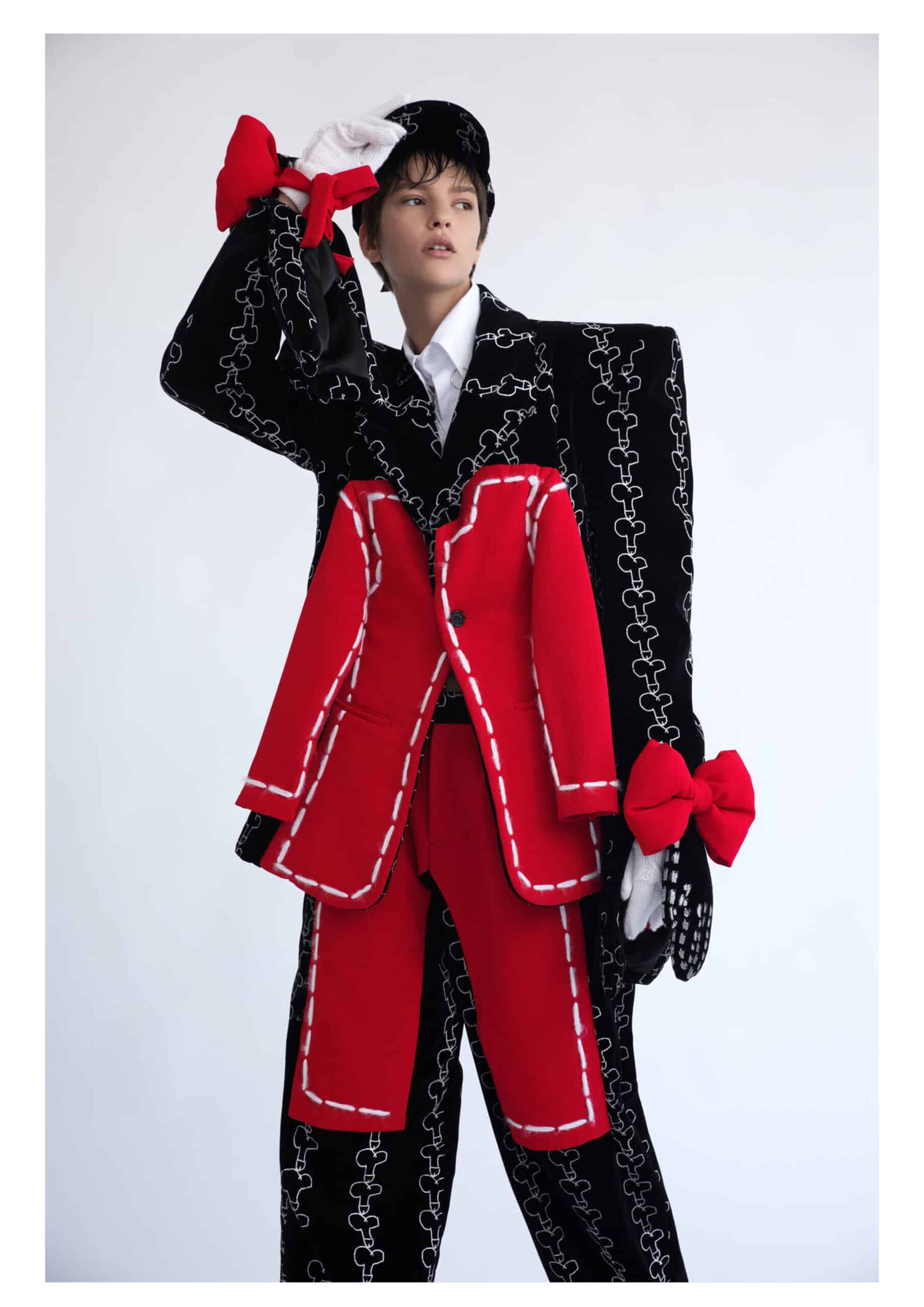Library
THE GUIDE MOVES A LITTLE, STANDING AT THE ENTRANCE TO THE LIBRARY (BUT NOT YET LETTING VISITORS IN)
Approximately 9,000 of the almost 15,000 portfolios received over 20 years are kept in this, for us, magical place. 6,000 of these, in fact, are kept in another space with the oversized projects.
LA GUIDA ENTRA NELLA LIBRARY PRENDE IL TELECOMANDO (IN INGRESSO) PER REGOLARE IL VOLUME DEL VIDEO MAPPING E SI POSIZIONA AL CENTRO DEL BANCONE E FA DEFLUIRE ( TIPO HOSTESS DI VOLO) I VISITATORI A DX E SX:
For us, the LIBRARY represents the temple of design, celebrating thought taking shape through a creative process that materialises in paper, textile or digital medium.
Each project is housed in a case, you are literally surrounded by them. On each one is a barcode that allows us to recognise them through a database in which their location is also indicated. A soon-to-be-available app will allow you to independently access much more information about the archive.
But what is a PORTFOLIO?
A portfolio represents the bridge between the artist's idea and the materialisation of this idea. Through a portfolio, we are able to discover how each artist has interpreted his or her concept of creativity by transforming an idea into something material.
Now take a look at the centre glass cabinet where you will find a video where we show you how a portfolio is structured. Normally a portfolio is created following 5 steps:
- 1. the idea or concept:
the artist always starts from an idea, a concept they want to express. This concept has to be written down, to get it out of their mind and onto paper.
2. the research: which represents the path of elaboration and deepening of that idea, that concept; the artist goes in search of images, visual references that illustrate the initial idea, whatever is of inspiration connected to the concept in order to start visualising colours, techniques and shapes.
3. the development diary: all this "creative material" collected is developed and arranged in the manner the artist deems most suitable: photos, poems, books, images and so on are coherently assembled in a moodboard, a blackboard of inspiration 4. the sketches: in this phase the creative starts to put the pieces together, through drawing (whether by hand or computer) and elaborate everything that has been collected in their diary to develop the initial idea, as it begins to materialise.
All these phases, however, can be interchangeable, can intersect and contaminate each other. You have to think that we are always in the field of a creative process that has no barriers or limits. 5. materials: the final part begins, the more physical part, being the choice of materials, of fabrics, and we begin to understand what the final object will look like and how it will be made.
In the final part of the process the collection or individual object is completed and produced, it is often contextualised within their world, their imagination, through a photo shoot that completes and enhances its characteristics.
As you can guess from what we have told you, a portfolio is much more than just paper and fabric. A portfolio is the testimony of a path, of the passion and hard work required to tackle it in search of new perspectives of beauty. Some of these creatives from these projects have built careers, translating their passion into work.
Look around, you are surrounded by portfolios. You find them:
(SHOWING EACH TIME)
- in niches
- in display cases
- filed in cases
- digitally narrated in a book.
(THE GUIDE MOVES TOWARDS THE DIGITAL BOOK AND INVITES VISITORS TO GATHER TO BEGIN THE STORY OF THE DIGITISED PORTFOLIO)
...this is the digitisation of a portfolio, containing the project of Tomohiro Sato, fashion finalist in 2013. This mode allows you to enter Tomohiro's imagination through a fantasy and dreamlike sensory experience, aimed at stimulating your creativity.
THE GUIDE STARTS THE STORY AS GUIDE OPENS THE FIRST PAGE. FOLLOWS THE SECOND AND THIRD (dark pages) CONTINUING THE NARRATION. AFTER WHICH GUIDE INVITES A VISITOR TO CONTINUE TURNING PAGES AS GUIDE TURNS TO THE VIDEO MAPPING CONTINUING THE NARRATIVE UNTIL HE/SHE SEES THE CLOSING OF A PORTFOLIO ON THE VIDEO MAPPING.
(story 1 portfolio opening and closing 3'40 "approx.)
As you can see, there are all the development phases we mentioned earlier, starting with the concept:
Tomohiro Sato
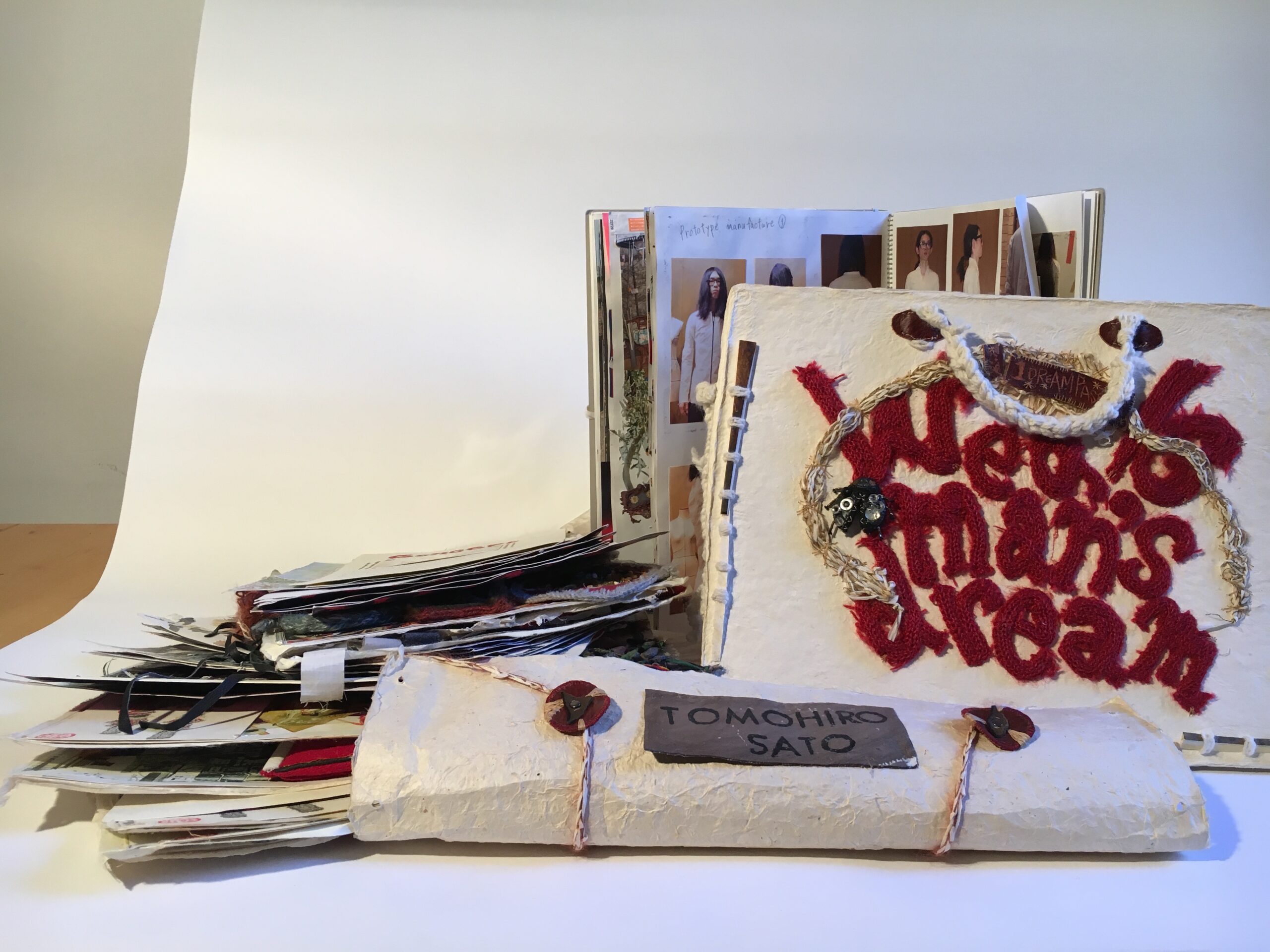
2013 TOMOHIRO SATO
“WEAK MAN'S DREAM"
The collection is a deeply personal, visionary journey of the artist who takes us to a surreal playground. It is a tribute to Tomohiro's grandfather, who passed away after a long illness that caused him so much suffering: the playground symbolises Tomohiro's wish to be able to give his grandfather a place in the afterlife where he can finally be happy and forget the pain. All the toys in the park are inspired by his grandfather and his personal memories, which Tomohiro decided to transform into his clothes. The designs come from his unconscious, his memories create his style. The clothes are inspired by samurai culture and Tyrolean folklore and are made to keep these memories alive. Here you can see how from the idea, step by step, Tomohiro arrived at the actual materialisation of the clothes. The portfolio in his case becomes itself a real artistic research tool, extremely personal.
THE GUIDE DRAWS THE VISITORS' ATTENTION TO THE OPPOSITE WALL.
Now turn towards the opposite side of the Library: you will see projected a video-mapping in which you are accompanied inside a portfolio, or rather inside 3 portfolios, through the voice of Barbara Franchin, President and founder of ITS, who flicking through the portfolios tells you about them. Let's get closer.
THE GUIDE INVITES VISITORS TO MOVE TOWARDS THE VIDEO MAPPING AND LISTEN TO THE NARRATION OF A PORTFOLIO AFTER TURNING UP THE VOLUME. AT THE END OF THE NARRATION HE LOWERS THE VOLUME AGAIN.
At the end of each story, you will see the portfolio close and magically re-enter its place on the shelf, while the next one comes out and opens to tell a new story. Beautiful, isn't it?
To conclude our journey through the Library, we have displayed a selection of portfolios inside the showcases to show you the more material side of them, developed and finished by the artist.
LA GUIDA RACCONTA 2/3 PORTFOLIO ESPOSTI:
We start with Yoshikazu Yamagata who is on the right of the central board.
2004 Yoshikazu Yamagata
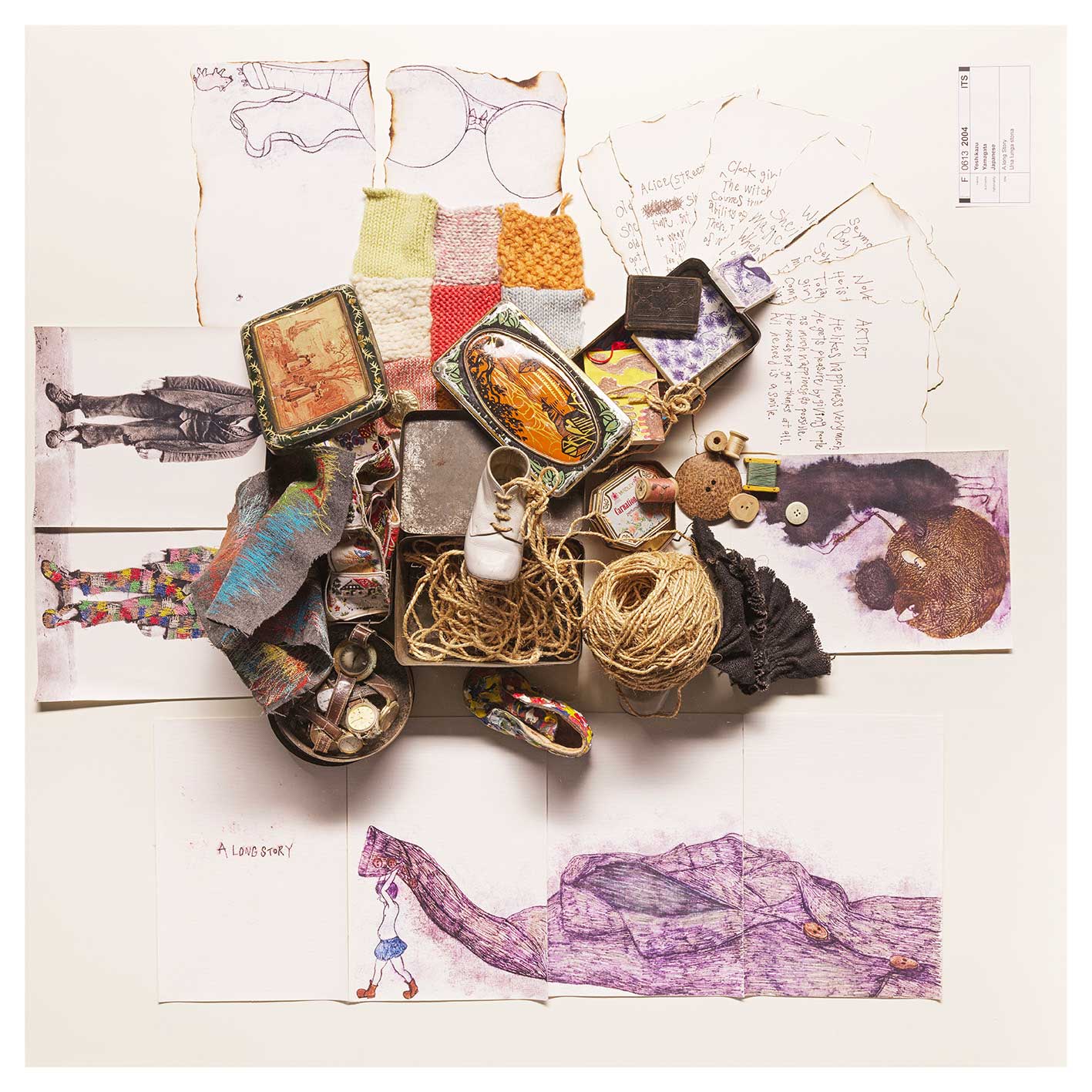
2004 YOSHIKAZU YAMAGATA
A LONG STORY
Yoshikazu Yamagata is a perfect example of Japanese creativity, a unique creativity that has the ability to remove any filter from the oneiric: the dream, the idea, it arrives directly to the real world without any modification, without following any rules or constructs to adapt. Back in Japan following ITS, Yoshi opened a school together with other finalists, dedicated to training such designers, true dream materialisers. The collection we are looking at is a visionary dream populated by seemingly unconnected characters, each with their own individual stories: the child who steals a giant bra from a cave, a writer at work while his mind is occupied by a date with a girl, a homeless man... each character carries real-life symbolism, some evocative others to be imagined... for example, does the child steal the bra as a wish to return to his mother? or as an expression of gender choice? In other characters feelings were only implied in the portfolio, such as the second child you can see in the drawings on display, who wears a gigantic jacket, as if to symbolise the weight of adulthood against the (undressed and free) innocence of childhood.
On the left you will find Ek Thongprasert
2007 EK THONGPRASERT
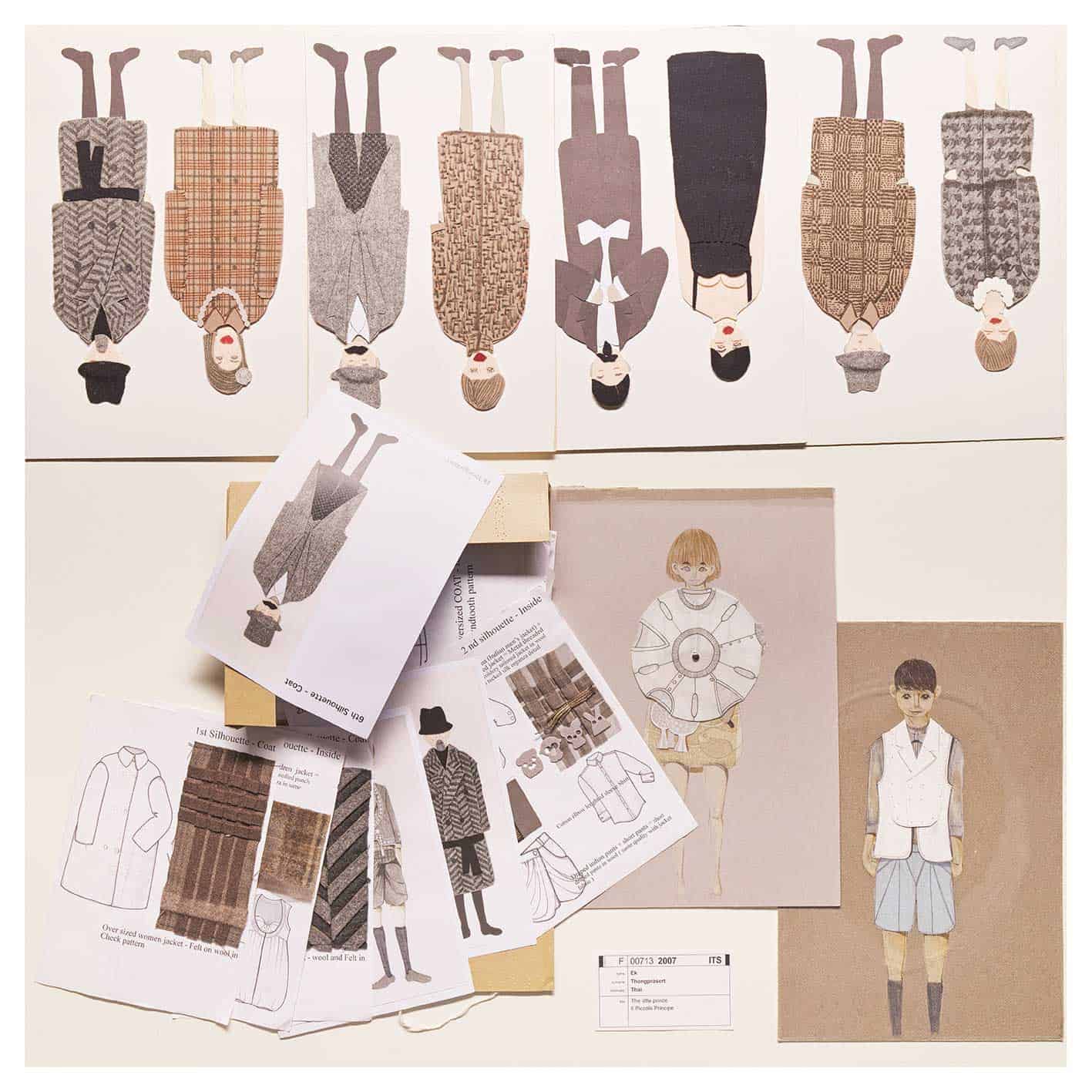
2007 EK THONGPRASERT
THE LITTLE PRINCE
Childhood as a theme has been addressed and articulated over the years by numerous finalists. Ek Thongprasert, from Thailand, starts from Saint-Exupéry's Little Prince to develop a collection that is a visual metaphor for the relationship with the child within us. The exterior represents adulthood, characterised by heavy, rigid garments, layered to the point of translating a barbed wire into three dimensions. The mask is the conformist mask worn to face society. But once the mask is taken off, and the coats removed, the child within is revealed: light fabrics, pastel colours that recall lightness, the sky, and embroidered details of childhood, of our true sending, of our freedom. Ek is also an excellent example of a designer who develops complex concepts - the pivotal theme is childhood, but there are sub-layers referring to the caste structure of Indian society, family trees and much more - from which articulate research has been carried out.
Finally, in the centre you can see the portfolio of Aharon Israel Genish
2020 Aharon Israel Genish
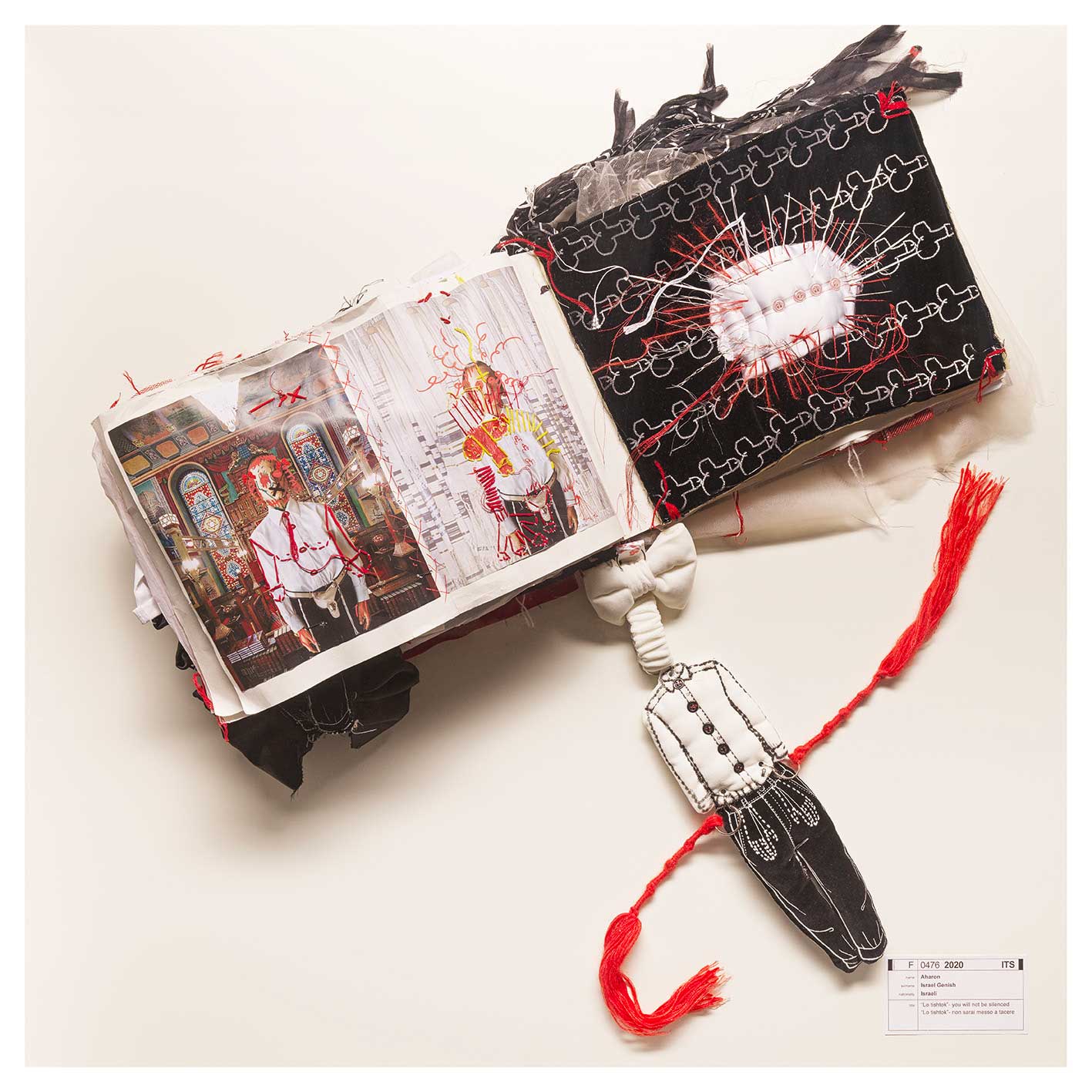
2020 AHARON ISRAEL GENISH:
“LO TISHTOK”- YOU WILL NOT BE SILENCED
For this Israeli designer, the collection becomes catharsis, the resolution of a childhood trauma: sexual abuse experienced within his ultra-orthodox Jewish community. Already from the portfolio we enter artistically into the aesthetic and visual canons of the collection's clothes. Here the designer experiments with his senses, with different textures, thicknesses, colours. He sews directly onto the portfolio because he is constantly searching, searching through the portfolio that became a tool, for that aesthetic he wants to bring to the clothes. It is a tale in images of the resolution of his trauma.
As you can see, languages are extremely diverse
THE GUIDE LEAVES SOME TIME FOR THE VISITORS TO TAKE A CLOSER LOOK AT THE EXHIBITED PORTFOLIOS OR FOR ANY QUESTIONS AND THEN INVITES THE VISITORS TO COME OUT AND STAND IN FRONT OF THE CURATOR'S VIDEO.
THE GUIDE MUST REMEMBER TO PUT THE REMOTE CONTROL BACK IN ITS PREDEFINED PLACE
2020 Rei Sato, Yumi Tanabe
Inside Out/ L'interno fuori
2020 Shiori Mizuoki, Hiroki Okamoto
Colour Chaser / Il cacciatore di colori
2019 Giovanni Pacienza
Arberia
2012 Momoko Okusa
MÀSCARA CONTRA MÀSCARA
2020 Rafaela Pestritu
My granny is a hacker / Mia nonna è un hacker
2010 David Longshaw
Escaping Emily / In fuga da Emily
2009 Letizia Vicenzi
Opening - Closing /
Aprire - chiudere
2003 Fabrizio Talia
A Sort of Fairy Tale / Un sorta di favola
2020 Alice Piscedda
Briseadh
2013 Takahiro Ueno
It's better to burn out than to fade away /
E' meglio bruciare in fretta che spegnersi lentamente
2014 Hiroki Kataoka
The soul of a boy / L'animo di un bambino
2006 Matthieu Blazy
Untitled / Senza Titolo
2006 Heaven Tanudiredja
Trapped in a gold portrait / Intrappolato in un ritratto dorato
2007 Yael Ben Ari
Berta
2005 Momoko Hashigami
Returning to myself / Ritorno a me stessa
2015 Yuko Koike
Blooming flowers of japanese painting /
Fiori che sbocciano nei dipinti giapponesi
2006 Joan Tarragò Pampalona, Karen Scholz
Tripscils / Matite da viaggio
2015 Shay Tako
In the beginning / In principio
